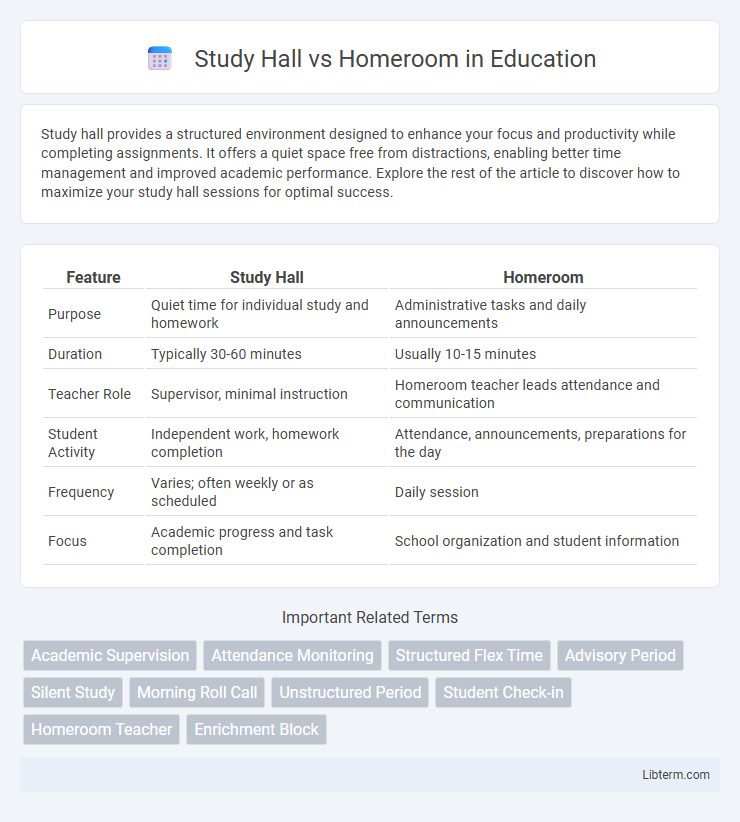Study hall provides a structured environment designed to enhance your focus and productivity while completing assignments. It offers a quiet space free from distractions, enabling better time management and improved academic performance. Explore the rest of the article to discover how to maximize your study hall sessions for optimal success.
Table of Comparison
| Feature | Study Hall | Homeroom |
|---|---|---|
| Purpose | Quiet time for individual study and homework | Administrative tasks and daily announcements |
| Duration | Typically 30-60 minutes | Usually 10-15 minutes |
| Teacher Role | Supervisor, minimal instruction | Homeroom teacher leads attendance and communication |
| Student Activity | Independent work, homework completion | Attendance, announcements, preparations for the day |
| Frequency | Varies; often weekly or as scheduled | Daily session |
| Focus | Academic progress and task completion | School organization and student information |
Understanding the Concept: What Is Study Hall?
Study Hall is a designated period in a school schedule where students engage in independent work, study, or complete assignments without direct instruction from a teacher. Unlike Homeroom, which serves as a time for administrative tasks, attendance, and announcements, Study Hall prioritizes focused academic productivity and time management. This structured environment helps students develop self-discipline and effective study habits essential for academic success.
Defining Homeroom: Purpose and Structure
Homeroom serves as the initial gathering period for students to receive daily announcements, take attendance, and organize materials, establishing a structured start to the school day. Its purpose is to foster a sense of community, provide administrative support, and facilitate communication between teachers and students. The typical structure of homeroom includes a fixed group of students assigned to a specific teacher, promoting consistency and routine.
Key Differences Between Study Hall and Homeroom
Study hall primarily provides students with dedicated time for independent study, homework completion, or quiet review, whereas homeroom serves as a structured period for attendance, announcements, and administrative tasks at the start of the school day. Study hall environments emphasize minimal teacher interaction to promote self-directed learning, while homeroom often includes teacher-led activities that prepare students for daily schedules and school culture. Key differences include the purpose--academic focus in study hall versus organizational focus in homeroom--and the level of supervision and student engagement during the sessions.
Academic Benefits of Study Hall
Study hall offers dedicated time for students to complete homework, review material, and prepare for exams, directly enhancing academic performance. It provides a structured environment with fewer distractions compared to homeroom, allowing for focused individual study and improved retention of information. Access to teachers or tutors during study hall further supports personalized learning and timely clarification of academic challenges.
Social and Administrative Roles of Homeroom
Homeroom serves key social and administrative functions by fostering student community through daily attendance, announcements, and distribution of important information. It provides a structured environment for teachers to address individual student needs, facilitate peer interaction, and promote school culture. Study hall primarily offers unsupervised academic work time, lacking the formal social and organizational responsibilities inherent to homeroom.
How Study Hall Supports Independent Learning
Study Hall fosters independent learning by providing students with dedicated time to complete assignments, review materials, and develop self-regulation skills without direct teacher instruction. This environment encourages effective time management, critical thinking, and personal responsibility, essential for academic success. Unlike homeroom, which primarily serves administrative purposes and morning announcements, Study Hall actively supports students' autonomy in their educational progress.
Homeroom as a Hub for Student Engagement
Homeroom functions as a central hub for student engagement by fostering a consistent environment where students receive important announcements, check in with teachers, and build a sense of community. Unlike study hall, which primarily offers unstructured time for individual academic work, homeroom emphasizes social connection, organization, and emotional support essential for student success. This dedicated space enhances communication and helps educators monitor attendance, distribute resources, and promote a positive school culture.
Which Is More Effective for Student Success?
Study Hall provides structured time for students to complete assignments and receive individualized support, enhancing academic achievement and time management skills. Homeroom primarily serves administrative purposes, such as attendance and announcements, offering limited direct academic benefit. Research indicates Study Hall's focused environment fosters higher student success by promoting self-discipline and personalized learning opportunities.
Student and Teacher Perspectives: Study Hall vs Homeroom
Study Hall offers students a structured environment for independent work, enabling teachers to provide targeted academic support and individual assistance. Homeroom focuses on administrative tasks, attendance, and daily announcements, fostering a sense of community and routine but limiting instructional interaction. From a student perspective, Study Hall maximizes productivity, while teachers value Homeroom for communication and classroom management.
Choosing the Right Approach for Schools
Schools must evaluate student needs and academic goals to choose between Study Hall and Homeroom effectively. Study Hall provides structured time for homework and individualized study, enhancing academic performance and focus, while Homeroom fosters community building, attendance management, and daily announcements to support student engagement. Balancing these priorities enables schools to create a supportive learning environment tailored to their unique educational objectives.
Study Hall Infographic

 libterm.com
libterm.com